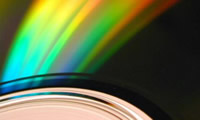Here we will try to explain in simple terms what organic based CD-R dye's are and how they are used and by who. |
 |
Introduction |
||||||||||||||||||||||||||||||||||||||||||||||||||
| The dye of a CD-R is the organic layer which records the actual data. Here is an overview of all available Dye materials, all organic based: | ||||||||||||||||||||||||||||||||||||||||||||||||||
|
||||||||||||||||||||||||||||||||||||||||||||||||||
The Formazan Dye is a hybrid Cyanine/PhthaloCyanine combination which has been developed by Kodak. |
||||||||||||||||||||||||||||||||||||||||||||||||||
CD Structure |
||||||||||||||||||||||||||||||||||||||||||||||||||
| Unlike an ordinary CD, the CD-R has
an organic dye recording layer between the polycarbonate substrate
and the light reflective layer. In addition, the polycarbonate substrate
is etched with a spiral pre-groove. This pre-groove is used for guiding
the laser beam, time measurement and various controls during recording. The laser beam, modulated by the recording signal, is focused on the groove. The beam heats and melts the recording layer of organic dye on the polycarbonate substrate, forming a series of pits. This pits are physically extremely stable, and are ideal for long-term data storage with the highest degree of reliability. |
||||||||||||||||||||||||||||||||||||||||||||||||||
 Click To Enlarge |
||||||||||||||||||||||||||||||||||||||||||||||||||
The Color to Dye for... |
||||||||||||||||||||||||||||||||||||||||||||||||||
| The different colors which show up
when you look at the bottom of the CD-R are a combination of the reflection
layer and the dye color (e.g. a Blue dye and a Gold reflection layer
will generate a Green colored bottom): |
||||||||||||||||||||||||||||||||||||||||||||||||||
|
||||||||||||||||||||||||||||||||||||||||||||||||||
| This is a list of the current Dye Types (the list is not complete yet): | ||||||||||||||||||||||||||||||||||||||||||||||||||
|
||||||||||||||||||||||||||||||||||||||||||||||||||
| All other CD-R manufacturers have
their CD-R's made by the above companies or they license the patent
to be able to make CD-R's. The color of the CD-R disc is related to the color of the specific dye that was used in the recording layer. This base dye color is modified when the reflective coating (gold or silver) is added. Some of the dye-reflective coating combinations appear green, some appear blue and others appear yellow/gold. Visual differences between various media types are irrelevant from the standpoint of their actual operation. At 780 nm, where CD-R recorders and CD-ROM readers function, the media are, for all intents and purposes, indistinguishable from an optical recording standpoint. They all "look" the same to the devices. The gold-colored CD-R uses the PhthaloCyanine pigment and a gold reflection layer. As the pigment is transparent, the golden reflection layer shines through the bottom side giving the `golden' look. Compared to the other colored media, the reflection contrast of the golden medium is the highest and the durability of such CD-R's is said to be over 100 years. As the golden medium's reflective property is the highest, if your friends or customers have problems reading data from any other burnt media, try using the gold medium CD-R. The green CD-R, the cheapest of the three, uses the Cyanine pigment. By itself, the pigment is blue in color, but
together with the gold reflective layer, the bottom appears green.
However, cyanine's ability to maintain reflectivity is poor giving
it a life span of about 10 years. It also delivers the weakest reflection
contrasts and thus can cause read errors when run on old CD-ROM drives. The blue media is made of Azo pigments. Like cyanine, it is blue in color but unlike the green CD-R it uses a silver reflection layer which gives the blue color. Manufacturers claim blue CD-R's are as durable as golden ones. |
||||||||||||||||||||||||||||||||||||||||||||||||||

